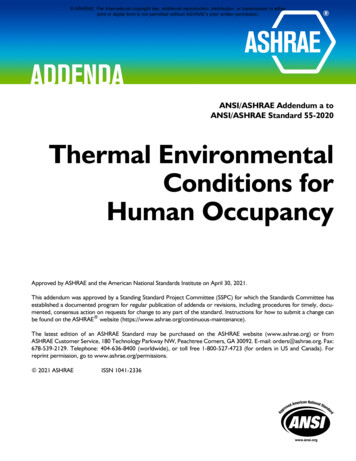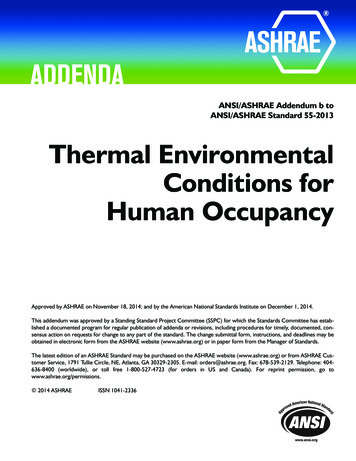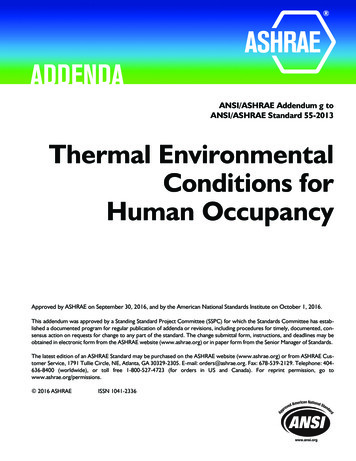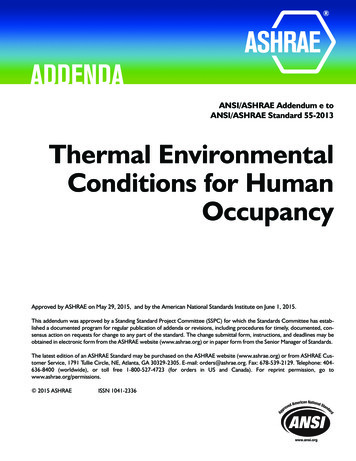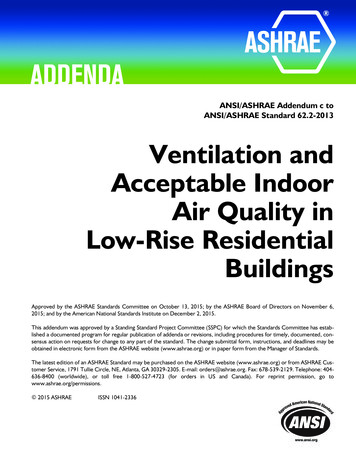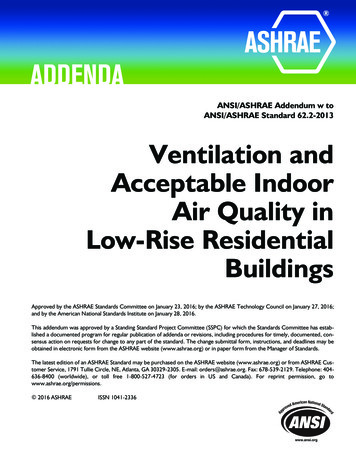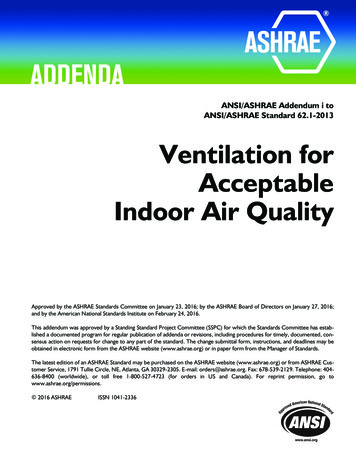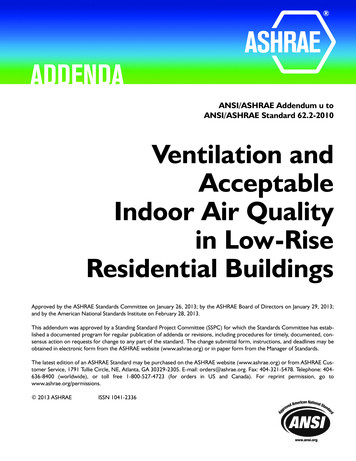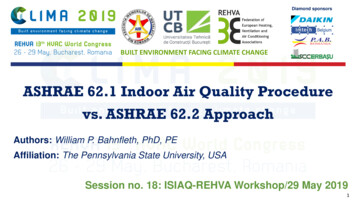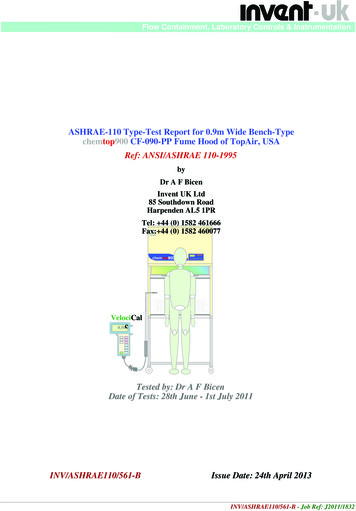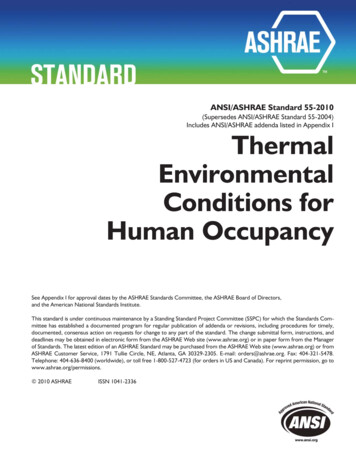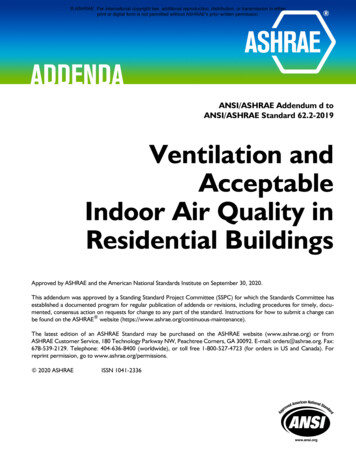
Transcription
ASHRAE. Per international copyright law, additional reproduction, distribution, or transmission in eitherprint or digital form is not permitted without ASHRAE's prior written permission.ANSI/ASHRAE Addendum d toANSI/ASHRAE Standard 62.2-2019Ventilation andAcceptableIndoor Air Quality inResidential BuildingsApproved by ASHRAE and the American National Standards Institute on September 30, 2020.This addendum was approved by a Standing Standard Project Committee (SSPC) for which the Standards Committee hasestablished a documented program for regular publication of addenda or revisions, including procedures for timely, documented, consensus action on requests for change to any part of the standard. Instructions for how to submit a change canbe found on the ASHRAE website e latest edition of an ASHRAE Standard may be purchased on the ASHRAE website (www.ashrae.org) or fromASHRAE Customer Service, 180 Technology Parkway NW, Peachtree Corners, GA 30092. E-mail: orders@ashrae.org. Fax:678-539-2129. Telephone: 404-636-8400 (worldwide), or toll free 1-800-527-4723 (for orders in US and Canada). Forreprint permission, go to www.ashrae.org/permissions. 2020 ASHRAEISSN 1041-2336
ASHRAE. Per international copyright law, additional reproduction, distribution, or transmission in eitherprint or digital form is not permitted without ASHRAE's prior written permission.ASHRAE Standing Standard Project Committee 62.2Cognizant TC: 4.3, Ventilation Requirements and InfiltrationSPLS Liaison: Karl L. PetermanIain S. Walker*, ChairJames C. Moore, III*, Vice-ChairNick H. Agopian*David A. Baylon*Michael D. BlanfordHoy R. Bohanon, Jr.*Randy Brannen*Randall L. CooperShannon Corcoran*Gary CrawRoy R. Crawford*David C. Delaquila*S. Craig Drumheller*Steven J. Emmerich*Philip W. Fairey*Sama Fakhimi*Paul Francisco*Patricia M. Fritz*Stephen E. GatzMarian GoebesPaul GrahovacGregg Gress*Henry T. GreistSanjeev K. HingoraniNicholas HurstMark C. Jackson*David E. Jacobs*Richard J. Karg*Richard E. Lambert, Jr.Kimberly Llewellyn*Joseph W. LstiburekMichael R. Lubliner*Darren B. Meyers*Jeff R. Miller*Amy B. MusserKashif NawazDavid T. NoyesCollin Olson*Joseph J. PessaPaul H. Raymer*John S. Saunders*Armin RuddMax H. Sherman*Don T. Stevens*R. VijayakumarEric D. Werling*Ted A. Williams** Denotes members of voting status when the document was approved for publicationASHRAE STANDARDS COMMITTEE 2020–2021Drury B. Crawley, ChairRick M. Heiden, Vice ChairEls BaertCharles S. BarnabyRobert B. BurkheadThomas E. CappellinDouglas D. FickWalter T. GrondzikSusanna S. HansonJonathan HumbleSrinivas KatipamulaGerald J. KettlerEssam E. KhalilMalcolm D. KnightJay A. KohlerLarry KoumaCesar L. LimJames D. LutzKarl L. PetermanErick A. PhelpsDavid RobinLawrence J. SchoenSteven C. SillRichard T. SwierczynaChristian R. TaberRussell C. TharpTheresa A. WestonCraig P. WrayJaap Hogeling, BOD ExOWilliam F. McQuade, COConnor Barbaree, Senior Manager of StandardsSPECIAL NOTEThis American National Standard (ANS) is a national voluntary consensus Standard developed under the auspices of ASHRAE. Consensus is definedby the American National Standards Institute (ANSI), of which ASHRAE is a member and which has approved this Standard as an ANS, as“substantial agreement reached by directly and materially affected interest categories. This signifies the concurrence of more than a simple majority,but not necessarily unanimity. Consensus requires that all views and objections be considered, and that an effort be made toward their resolution.”Compliance with this Standard is voluntary until and unless a legal jurisdiction makes compliance mandatory through legislation.ASHRAE obtains consensus through participation of its national and international members, associated societies, and public review.ASHRAE Standards are prepared by a Project Committee appointed specifically for the purpose of writing the Standard. The ProjectCommittee Chair and Vice-Chair must be members of ASHRAE; while other committee members may or may not be ASHRAE members, allmust be technically qualified in the subject area of the Standard. Every effort is made to balance the concerned interests on all Project Committees.The Senior Manager of Standards of ASHRAE should be contacted fora. interpretation of the contents of this Standard,b. participation in the next review of the Standard,c. offering constructive criticism for improving the Standard, ord. permission to reprint portions of the Standard.DISCLAIMERASHRAE uses its best efforts to promulgate Standards and Guidelines for the benefit of the public in light of available information and acceptedindustry practices. However, ASHRAE does not guarantee, certify, or assure the safety or performance of any products, components, or systemstested, installed, or operated in accordance with ASHRAE’s Standards or Guidelines or that any tests conducted under its Standards or Guidelineswill be nonhazardous or free from risk.ASHRAE INDUSTRIAL ADVERTISING POLICY ON STANDARDSASHRAE Standards and Guidelines are established to assist industry and the public by offering a uniform method of testing for rating purposes, bysuggesting safe practices in designing and installing equipment, by providing proper definitions of this equipment, and by providing other informationthat may serve to guide the industry. The creation of ASHRAE Standards and Guidelines is determined by the need for them, and conformanceto them is completely voluntary.In referring to this Standard or Guideline and in marking of equipment and in advertising, no claim shall be made, either stated or implied,that the product has been approved by ASHRAE.ASHRAE is a registered trademark of the American Society of Heating, Refrigerating and Air-Conditioning Engineers, Inc.ANSI is a registered trademark of the American National Standards Institute.
ASHRAE. Per international copyright law, additional reproduction, distribution, or transmission in eitherprint or digital form is not permitted without ASHRAE's prior written permission.(This foreword is not part of this standard. It is merely informative and does not containrequirements necessary for conformance to the standard. It has not been processedaccording to the ANSI requirements for a standard and may contain material that hasnot been subject to public review or a consensus process. Unresolved objectors on informative material are not offered the right to appeal at ASHRAE or ANSI.)FOREWORDAddendum d replaces the current definition of “readily accessible” with a new definition fromthe 2020 National Electrical Code (NEC) intended to be less ambiguous and more compatiblewith building codes. Addendum d also adds a new definition of “accessible,” and makes editsin the standard to refer to one of the two definitions where needed.Note: In this addendum, changes to the current standard are indicated in the text by underlining (for additions) and strikethrough (for deletions) unless the instructions specifically mention some other means of indicating the changes.Addendum d to Standard 62.2-2019Revise Section 3 as shown. The remainder of Section 3 is unchanged.readily accessible: capable of being quickly and easily reached for operation, maintenance,and inspection.accessible: capable of being reached for operation, renewal, inspection, removal, and exposurewithout damaging the building structure or finish.accessible, readily: capable of being reached quickly for operation, renewal, or inspectionswithout requiring those to whom ready access is requisite to take actions such as use tools(other than keys), climb over or under, remove obstacles, or resort to portable ladders.Add a new Section A2.1 as shown.A2.1 Control. The control required by Section 4.4.1 shall be accessible to the dwelling-unitoccupant but shall not be required to be readily accessible to the dwelling-unit occupant.Revise Section A5 as shown. The remainder of Section A5 is unchanged.A5. DWELLING-UNIT AIR SEALING[.]A5.1 The spaces around readily accessible penetrations through the dwelling-unit air barrier,including but not limited to the following, shall be sealed:a. Vent and pipe penetrations, including those from water piping, drain waste and vent piping,HVAC piping, and sprinkler headsb. Electrical penetrations, including those for receptacles, lighting, communications wiring,and smoke alarmsc. HVAC penetrations, including those for fans and for exhaust, supply, transfer, and return airductsA5.2 Readily aAccessible leaks and gaps in the dwelling-unit air barrier shall be sealed,including but not limited to the intersections of baseboard trim and floor, the intersections ofwalls and ceilings, around window trim and dwelling-unit doors, and the termination points ofinternal chases in attics and crawlspaces.A5.3 Where previously inaccessible locations are made readily accessible during renovationactivities, those areas shall be air sealed as prescribed in Sections A5.1 and A5.2.[.]ANSI/ASHRAE Addendum d to ANSI/ASHRAE Standard 62.2-20191
ASHRAE. Per international copyright law, additional reproduction, distribution, or transmission in eitherprint or digital form is not permitted without ASHRAE's prior written permission.POLICY STATEMENT DEFINING ASHRAE’S CONCERNFOR THE ENVIRONMENTAL IMPACT OF ITS ACTIVITIESASHRAE is concerned with the impact of its members’ activities on both the indoor and outdoor environment.ASHRAE’s members will strive to minimize any possible deleterious effect on the indoor and outdoor environment ofthe systems and components in their responsibility while maximizing the beneficial effects these systems provide,consistent with accepted Standards and the practical state of the art.ASHRAE’s short-range goal is to ensure that the systems and components within its scope do not impact theindoor and outdoor environment to a greater extent than specified by the Standards and Guidelines as established byitself and other responsible bodies.As an ongoing goal, ASHRAE will, through its Standards Committee and extensive Technical Committee structure,continue to generate up-to-date Standards and Guidelines where appropriate and adopt, recommend, and promotethose new and revised Standards developed by other responsible organizations.Through its Handbook, appropriate chapters will contain up-to-date Standards and design considerations as thematerial is systematically revised.ASHRAE will take the lead with respect to dissemination of environmental information of its primary interest andwill seek out and disseminate information from other responsible organizations that is pertinent, as guides to updatingStandards and Guidelines.The effects of the design and selection of equipment and systems will be considered within the scope of thesystem’s intended use and expected misuse. The disposal of hazardous materials, if any, will also be considered.ASHRAE’s primary concern for environmental impact will be at the site where equipment within ASHRAE’s scopeoperates. However, energy source selection and the possible environmental impact due to the energy source andenergy transportation will be considered where possible. Recommendations concerning energy source selectionshould be made by its members.
ASHRAE. Per international copyright law, additional reproduction, distribution, or transmission in eitherprint or digital form is not permitted without ASHRAE's prior written permission.ASHRAE · 180 Technology Parkway NW · Peachtree Corners, GA 30092 · www.ashrae.orgAbout ASHRAEFounded in 1894, ASHRAE is a global professional society committed to serve humanity by advancing the arts andsciences of heating, ventilation, air conditioning, refrigeration, and their allied fields.As an industry leader in research, standards writing, publishing, certification, and continuing education, ASHRAEand its members are dedicated to promoting a healthy and sustainable built environment for all, through strategicpartnerships with organizations in the HVAC&R community and across related industries.To stay current with this and other ASHRAE Standards and Guidelines, visit www.ashrae.org/standards, andconnect on LinkedIn, Facebook, Twitter, and YouTube.Visit the ASHRAE BookstoreASHRAE offers its Standards and Guidelines in print, as immediately downloadable PDFs, and via ASHRAE DigitalCollections, which provides online access with automatic updates as well as historical versions of publications.Selected Standards and Guidelines are also offered in redline versions that indicate the changes made between theactive Standard or Guideline and its previous version. For more information, visit the Standards and Guidelinessection of the ASHRAE Bookstore at www.ashrae.org/bookstore.IMPORTANT NOTICES ABOUT THIS STANDARDTo ensure that you have all of the approved addenda, errata, and interpretations for thisStandard, visit www.ashrae.org/standards to download them free of charge.Addenda, errata, and interpretations for ASHRAE Standards and Guidelines are no longerdistributed with copies of the Standards and Guidelines. ASHRAE provides these addenda,errata, and interpretations only in electronic form to promote more sustainable use ofresources.9/20
ANSI/ASHRAE Standard 62.2-2019 Ventilation and Acceptable Indoor Air Quality in Residential Buildings Approved by ASHRAE and the American National Standards Institute on September 30, 2020. This addendum was approved by a Standing Standard Project Committee (SSPC) for which the Standards Committee has established a documented program for regular publication of addenda or revisions,

